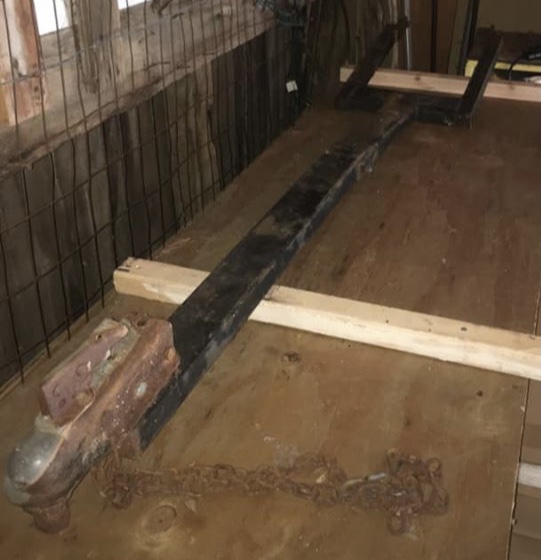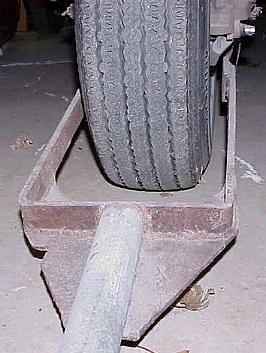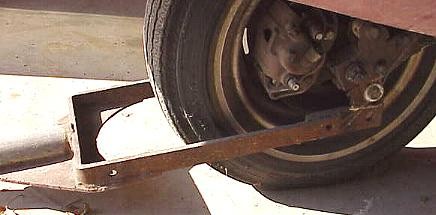Towbar for Litestar Pulse
A tow bar was a factory option and owners report good luck towing their Pulses.
WARNING: Always use safety chains. And make sure the bolts at the front wheel are tight.
Towbars for sale here
Owosso Motor Car Co. tested the Litestar for flat towing purposes. Here are a few photos.

Nice factory Tow Bar for Pulse #310

Build your own Towbar
Steve Cole's (Pulse #195) Towbar Design

by: Dave Bauer #167
The Pulse will follow along behind the tow vehicle much like a wagon follows the person pulling
it. The front wheel will turn with the towbar, which is being turned by the towing vehicle.
Likewise, when stopping, the towbar transfers all the momentum of the Pulse to the tow vehicle.
My only concern is that it seems that things could get out of control in a panick stop situation
when the Pulse is not directly lined up behind you, such as a quick stop on a freeway cloverleaf
or while making a turn at an intersection. Just a thought.
by: Bob Cervero:
It really makes no difference in this case if the tow bar is attached to the sprung or unsprung
part of the Pulse. The tow bar is not attached rigidly to the Pulse, nor the tow vehicle. There
is no tongue weight like a boat trailer for example.
Actually it's better for the tow bar to be attached directly to the front wheel when you hit a pot
hole. If you hit a large hole with the tow bar attached to the suspension, not the wheel, then the
front wheel is forced to the rear by the impact. This impact to the rear, however is no worse than
if you just drove the Pulse itself through the same hole.
If you hit the same hole while towing by the front wheel, then the wheel is not allowed to recoil
to the rear because it's being pulled forward by the tow bar. The impact is taken by the tow bar.
The suspension will absorb the upward movement no matter how you are towing the Pulse.
As a practical matter, the tow bar attached to the front wheel also steers the Pulse while towing
around a corner. It's hard to know how the quick steering of a Pulse would react to being towed by
the suspension. The front end might not follow the tow vehicle or get into a high speed wobble if
it is allowed to be unrestrained while towing.
Also, there is a long history of the Pulse being towed all over the place by the front wheel, mine
included. I have not heard of any problems. The previous owner of my Pulse #61 towed it from Venita,
Oklahoma to Reno, Nevada and back without a problem. I would however remove the drive chain for long
tows. Other than that, I wouldn't be concerned.
Thanks to Randy Pinkham for the pictures.
The overall length is 78"
There is a drop, from the hitch head to the middle of the tow bar of 3",
then it raises back up. This drop insures 'nose clearance' when towing the
Pulse with the front shock in the lowered position.
The bracket (where it attaches to the front hub) is 20" long and 9 1/2"
wide.








I had no trouble with towing my Pulse (1100 Goldwing w/ Shaft Drive) from Albuquerque,
N.M. to Altus, OK (over 450 miles) with the towbar. Towing speeds were as high as 70 MPH.
I understand the previous owner towed it from Michigan to Albuquerque, with no problem
either. I did contact the local Honda Shop before attempting this, and they stated that
(with the transmission in neutral) there would be no problem.
Steve Geroge
I built my towbar in less than 2 hours. Using two lengths of
tubing with a couple of flats welded to it on the ends, another short
section of tubing stacked and welded on the other end with a couple cross
braces, a hitch, and brackets made to fit the front swingarm.
The whole thing
cost about 50 bucks total....the hitch being the most expensive part.
I fitted the brackets first, then using heavy bolts for mounting (1/2 inch)
and 5/8th for the swing action. Then I fitted the drops to the tubing on each
side and then brought the two together and clamped, then tack welded. I then took
the assembly off the vehicle and finished the hitch allowing for the nose,
drop, ect.
Note I would not recommend this hitch for anything but a car,
due to the height. Otherwise you could hit the nose of the Litestar/Pulse.
I also
bolted everything and welded and used high quality bolts, washers and
self-locking nuts and installed a harnass for wiring and a plug-in for the tow lites.
Below is the towbar for the BD200

More about Pulse Trailers
Pulse Index











